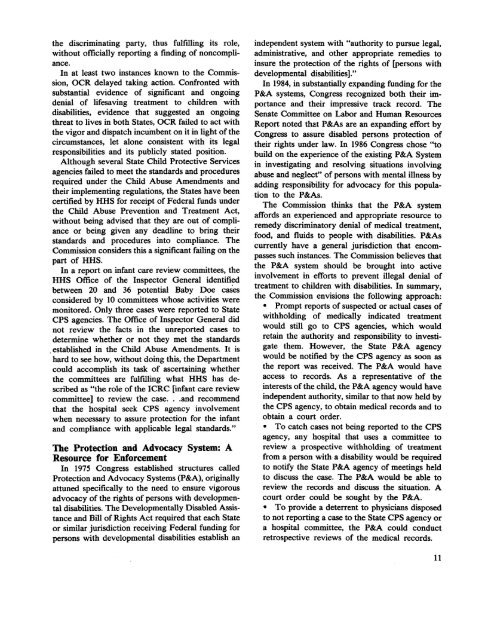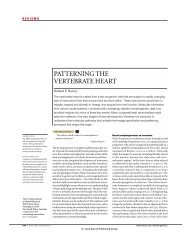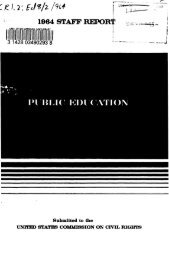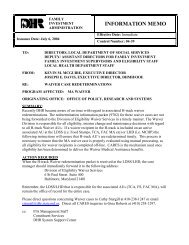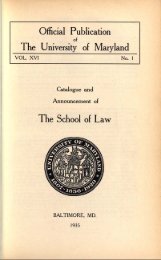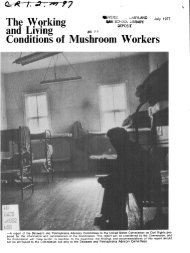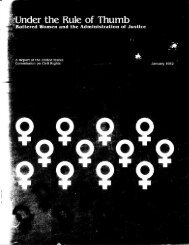PDF1 - University of Maryland School of Law
PDF1 - University of Maryland School of Law
PDF1 - University of Maryland School of Law
Create successful ePaper yourself
Turn your PDF publications into a flip-book with our unique Google optimized e-Paper software.
the discriminating party, thus fulfilling its role,without <strong>of</strong>ficially reporting a finding <strong>of</strong> noncompliance.In at least two instances known to the Commission,OCR delayed taking action. Confronted withsubstantial evidence <strong>of</strong> significant and ongoingdenial <strong>of</strong> lifesaving treatment to children withdisabilities, evidence that suggested an ongoingthreat to lives in both States, OCR failed to act withthe vigor and dispatch incumbent on it in light <strong>of</strong> thecircumstances, let alone consistent with its legalresponsibilities and its publicly stated position.Although several State Child Protective Servicesagencies failed to meet the standards and proceduresrequired under the Child Abuse Amendments andtheir implementing regulations, the States have beencertified by HHS for receipt <strong>of</strong> Federal funds underthe Child Abuse Prevention and Treatment Act,without being advised that they are out <strong>of</strong> complianceor being given any deadline to bring theirstandards and procedures into compliance. TheCommission considers this a significant failing on thepart <strong>of</strong> HHS.In a report on infant care review committees, theHHS Office <strong>of</strong> the Inspector General identifiedbetween 20 and 36 potential Baby Doe casesconsidered by 10 committees whose activities weremonitored. Only three cases were reported to StateCPS agencies. The Office <strong>of</strong> Inspector General didnot review the facts in the unreported cases todetermine whether or not they met the standardsestablished in the Child Abuse Amendments. It ishard to see how, without doing this, the Departmentcould accomplish its task <strong>of</strong> ascertaining whetherthe committees are fulfilling what HHS has describedas "the role <strong>of</strong> the ICRC [infant care reviewcommittee] to review the case. . .and recommendthat the hospital seek CPS agency involvementwhen necessary to assure protection for the infantand compliance with applicable legal standards."The Protection and Advocacy System: AResource for EnforcementIn 1975 Congress established structures calledProtection and Advocacy Systems (P&A), originallyattuned specifically to the need to ensure vigorousadvocacy <strong>of</strong> the rights <strong>of</strong> persons with developmentaldisabilities. The Developmentally Disabled Assistanceand Bill <strong>of</strong> Rights Act required that each Stateor similar jurisdiction receiving Federal funding forpersons with developmental disabilities establish anindependent system with "authority to pursue legal,administrative, and other appropriate remedies toinsure the protection <strong>of</strong> the rights <strong>of</strong> [persons withdevelopmental disabilities]."In 1984, in substantially expanding funding for theP&A systems, Congress recognized both their importanceand their impressive track record. TheSenate Committee on Labor and Human ResourcesReport noted that P&As are an expanding effort byCongress to assure disabled persons protection <strong>of</strong>their rights under law. In 1986 Congress chose "tobuild on the experience <strong>of</strong> the existing P&A Systemin investigating and resolving situations involvingabuse and neglect" <strong>of</strong> persons with mental illness byadding responsibility for advocacy for this populationto the P&As.The Commission thinks that the P&A systemaffords an experienced and appropriate resource toremedy discriminatory denial <strong>of</strong> medical treatment,food, and fluids to people with disabilities. P&Ascurrently have a general jurisdiction that encompassessuch instances. The Commission believes thatthe P&A system should be brought into activeinvolvement in efforts to prevent illegal denial <strong>of</strong>treatment to children with disabilities. In summary,the Commission envisions the following approach:• Prompt reports <strong>of</strong> suspected or actual cases <strong>of</strong>withholding <strong>of</strong> medically indicated treatmentwould still go to CPS agencies, which wouldretain the authority and responsibility to investigatethem. However, the State P&A agencywould be notified by the CPS agency as soon asthe report was received. The P&A would haveaccess to records. As a representative <strong>of</strong> theinterests <strong>of</strong> the child, the P&A agency would haveindependent authority, similar to that now held bythe CPS agency, to obtain medical records and toobtain a court order.• To catch cases not being reported to the CPSagency, any hospital that uses a committee toreview a prospective withholding <strong>of</strong> treatmentfrom a person with a disability would be requiredto notify the State P&A agency <strong>of</strong> meetings heldto discuss the case. The P&A would be able toreview the records and discuss the situation. Acourt order could be sought by the P&A.• To provide a deterrent to physicians disposedto not reporting a case to the State CPS agency ora hospital committee, the P&A could conductretrospective reviews <strong>of</strong> the medical records.11


